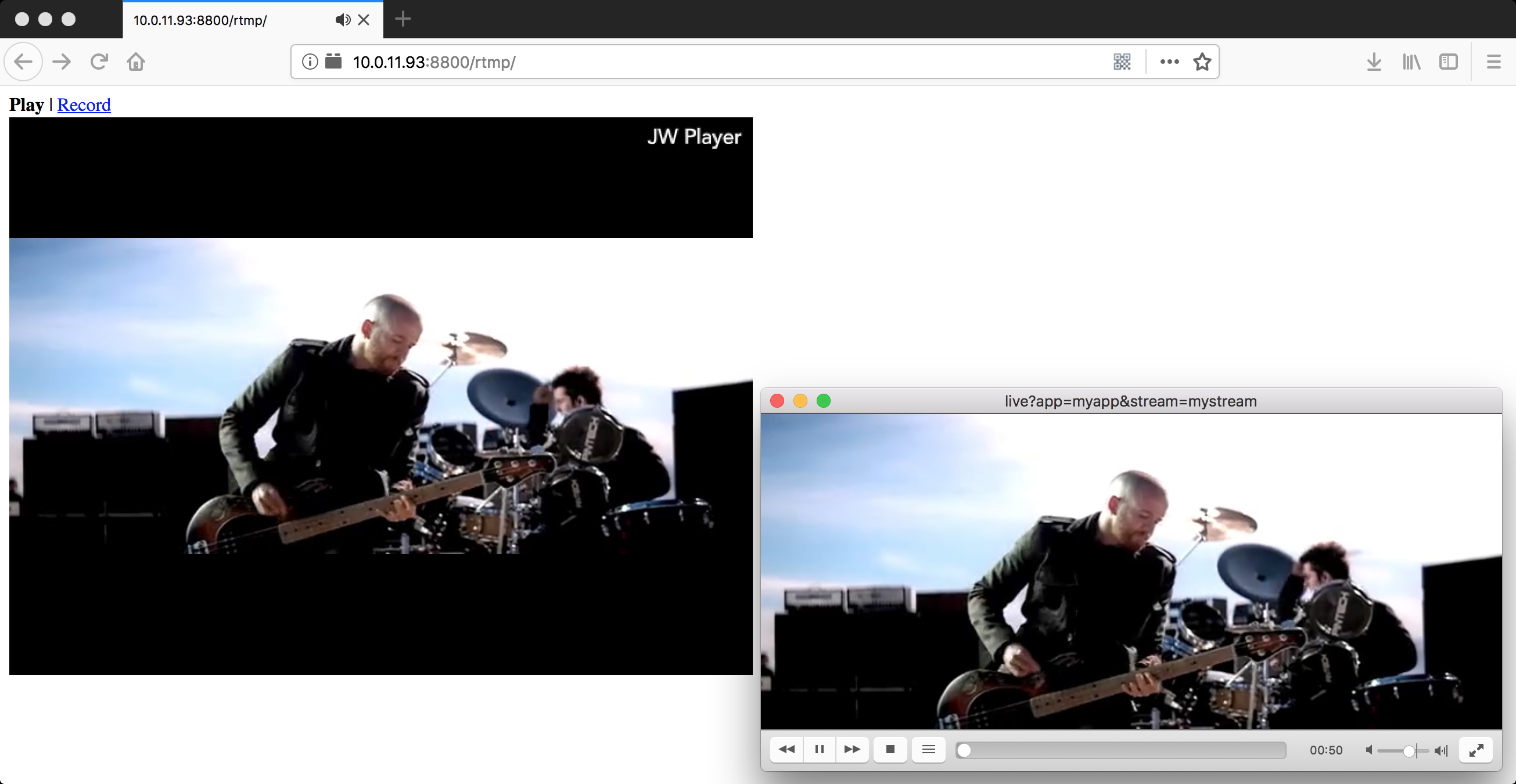Media streaming server based on nginx-rtmp-module.
中文说明.
Donate if you like this module. Many thanks to you!
-
Igor Sysoev, the creator of NGINX.
-
Roman Arutyunyan, who created nginx-rtmp-module.
-
Contributors, refer to AUTHORS for details.
-
All features nginx-rtmp-module provides.
-
Other features provided by nginx-http-flv-module vs nginx-rtmp-module:
| Features | nginx-http-flv-module | nginx-rtmp-module | Remarks |
|---|---|---|---|
| HTTP-FLV (subscribe) | √ | x | HTTPS-FLV and chunked response supported |
| GOP cache | √ | x | Only for H.264 video and AAC audio |
| VHOST | √ | x | |
Omit listen directive |
√ | See remarks | There MUST be at least one listen directive |
| Audio-only support | √ | See remarks | Won't work if wait_video or wait_key is on |
| Timing log for access | √ | x | |
| JSON style stat | √ | x |
- Linux (recommended)/FreeBSD/MacOS/Windows (limited).
flv.js can only run with browsers that support Media Source Extensions.
-
GNU make for activating compiler on Unix-like systems to compile software.
-
GCC for compilation on Unix-like systems or MSVC for compilation on Windows.
-
GDB for debug on Unix-like systems.
-
VLC (recommended) or flv.js (recommended) for playing media streams.
-
PCRE for NGINX if regular expressions needed.
-
OpenSSL for NGINX if encrypted access needed.
-
zlib for NGINX if compression needed.
nginx-http-flv-module has all features that nginx-rtmp-module provides, so DON'T compile nginx-http-flv-module along with nginx-rtmp-module.
For details of build steps, please refer to Building nginx on the Win32 platform with Visual C, and don't forget to add --add-module=/path/to/nginx-http-flv-module in Run configure script step.
Download NGINX and nginx-http-flv-module.
Uncompress them.
cd to NGINX source directory & run this:
Compile the module into NGINX
./configure --add-module=/path/to/nginx-http-flv-module
make
make install
or
./configure --add-dynamic-module=/path/to/nginx-http-flv-module
make
make install
If the module is compiled as a dynamic module, the NGINX version MUST be equal to or greater than 1.9.11.
For details of usages of nginx-rtmp-module, please refer to README.md.
For simplicity, transcoding is not used (so -vcodec copy -acodec copy is used):
ffmpeg -re -i example.mp4 -vcodec copy -acodec copy -f flv rtmp://example.com[:port]/appname/streamname
The appname is used to match an application block in rtmp block (see below for details).
The streamname can be specified at will.
The default port for RTMP is 1935, if some other ports were used, :port must be specified.
http://example.com[:port]/dir?[port=xxx&]app=myapp&stream=mystream
If ffplay is used in command line to play the stream, the url above MUST be enclosed by quotation marks, or arguments in url will be discarded (some shells not so smart will interpret "&" as "run in background").
The dir is used to match location blocks in http block (see below for details).
The default port for HTTP is 80, if some other ports were used, :port must be specified.
The default port for RTMP is 1935, if some other ports were used, port=xxx must be specified.
The app is used to match an application block, but if the requested app appears in several server blocks and those blocks have the same address and port configuration, host name matches server_name directive will be additionally used to identify the requested application block, otherwise the first one is matched.
The stream is used to match the publishing streamname.
Assuming that listen directive specified in http block is:
http {
...
server {
listen 8080; #not default port 80
...
location /live {
flv_live on;
}
}
}
And listen directive specified in rtmp block is:
rtmp {
...
server {
listen 1985; #not default port 1935
...
application myapp {
live on;
}
}
}
Then the url of playback based on HTTP is:
http://example.com:8080/live?port=1985&app=myapp&stream=mystream
Since some players don't support HTTP chunked transmission, it's better to specify chunked_transfer_encoding off; in location where flv_live on; is specified in this case, or play will fail.
rtmp://example.com[:port]/appname/streamname
http://example.com[:port]/dir/streamname.m3u8
http://example.com[:port]/dir/streamname.mpd
HTTP-FLV (flv.js)
Please refer to nginx-http-flv-module-packages.
The directives rtmp_auto_push, rtmp_auto_push_reconnect and rtmp_socket_dir will not function on Windows except on Windows 10 17063 and later versions, because relay in multiple processes mode needs help of Unix domain socket, please refer to Unix domain socket on Windows 10 for details.
The directive worker_processes of value 1 is preferable to other values, because there are something wrong with ngx_rtmp_stat_module and ngx_rtmp_control_module in multi-processes mode, in addtion, vhost feature is not perfect in multi-processes mode yet, wating to be fixed.
worker_processes 1; #should be 1 for Windows, for it doesn't support Unix domain socket
#worker_processes auto; #from versions 1.3.8 and 1.2.5
#worker_cpu_affinity 0001 0010 0100 1000; #only available on FreeBSD and Linux
#worker_cpu_affinity auto; #from version 1.9.10
error_log logs/error.log error;
#if the module is compiled as a dynamic module and features relevant
#to RTMP are needed, the command below MUST be specified and MUST be
#located before events directive, otherwise the module won't be loaded
#or will be loaded unsuccessfully when NGINX is started
#load_module modules/ngx_http_flv_live_module.so;
events {
worker_connections 1024;
}
http {
include mime.types;
default_type application/octet-stream;
keepalive_timeout 65;
server {
listen 80;
location / {
root /var/www;
index index.html index.htm;
}
error_page 500 502 503 504 /50x.html;
location = /50x.html {
root html;
}
location /live {
flv_live on; #open flv live streaming (subscribe)
chunked_transfer_encoding on; #open 'Transfer-Encoding: chunked' response
add_header 'Access-Control-Allow-Origin' '*'; #add additional HTTP header
add_header 'Access-Control-Allow-Credentials' 'true'; #add additional HTTP header
}
location /hls {
types {
application/vnd.apple.mpegurl m3u8;
video/mp2t ts;
}
root /tmp;
add_header 'Cache-Control' 'no-cache';
}
location /dash {
root /tmp;
add_header 'Cache-Control' 'no-cache';
}
location /stat {
#configuration of push & pull status
rtmp_stat all;
rtmp_stat_stylesheet stat.xsl;
}
location /stat.xsl {
root /var/www/rtmp; #specify in where stat.xsl located
}
#if JSON style stat needed, no need to specify
#stat.xsl but a new directive rtmp_stat_format
#location /stat {
# rtmp_stat all;
# rtmp_stat_format json;
#}
location /control {
rtmp_control all; #configuration of control module of rtmp
}
}
}
rtmp_auto_push on;
rtmp_auto_push_reconnect 1s;
rtmp_socket_dir /tmp;
rtmp {
out_queue 4096;
out_cork 8;
max_streams 128;
timeout 15s;
log_interval 5s; #interval used by log module to log in access.log, it is very useful for debug
log_size 1m; #buffer size used by log module to log in access.log
server {
listen 1935;
server_name www.test.*; #for suffix wildcard matching of virtual host name
application myapp {
live on;
gop_cache on; #open GOP cache for reducing the wating time for the first picture of video
}
application hls {
live on;
hls on;
hls_path /tmp/hls;
}
application dash {
live on;
dash on;
dash_path /tmp/dash;
}
}
server {
listen 1935;
server_name *.test.com; #for prefix wildcard matching of virtual host name
application myapp {
live on;
gop_cache on; #open GOP cache for reducing the wating time for the first picture of video
}
}
server {
listen 1935;
server_name www.test.com; #for completely matching of virtual host name
application myapp {
live on;
gop_cache on; #open GOP cache for reducing the wating time for the first picture of video
}
}
}


